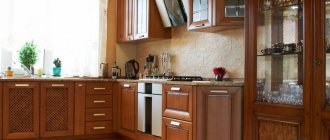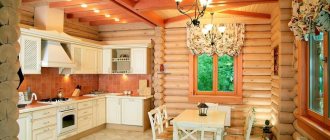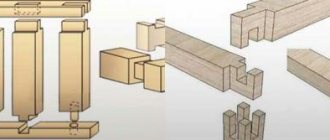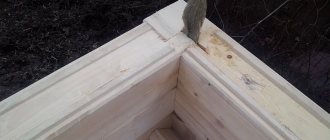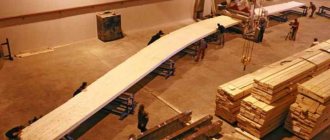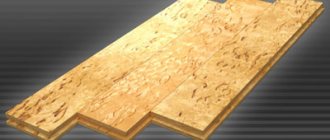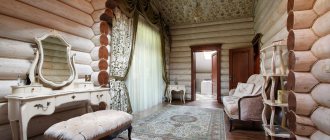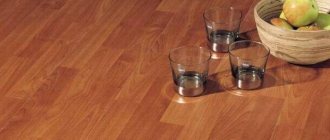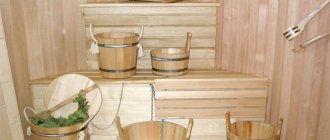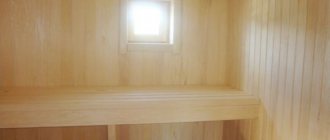Sometimes the influence of time can have a beneficial, rather than destructive, effect on objects. Things turn into antiques and become even more valuable and expensive. Patina, a fashionable and stylish decorative coating that occupies an honorable place in the world of design, can cope with such a task.
Thanks to patina, you can get an extraordinary antique effect, creating a charming atmosphere in any room, including the kitchen. Furniture pieces can become covered with natural patina only after many years of life; such a coating most often appears on copper products.
However, modern decorators have learned to create this amazing coating artificially, using special varnishes, paints and acids. With the help of such means, not only metal objects are aged, but also wooden furniture, as well as other materials.
The patina itself is a greenish tinge that appears on copper over time, under the influence of moisture and air. Patina gradually builds up in layers, making objects more mysterious and similar to museum exhibits.
The use of patina in kitchen interior design
Every housewife wants to have a special kitchen, with an interior that will amaze guests at first glance. Patination is one of the simplest and most accessible ways to achieve this effect. This technique, which makes it possible to artificially “age” objects, is most often used when decorating furniture.
It will be an excellent solution if you want to create a sophisticated and respectable interior with notes of true luxury. There are many patonation technologies, and each of them achieves different effects. For example, the design of a classic kitchen after such treatment will look elegant and solemn.
You can make a patina on furniture with your own hands using special varnishes, primers, finishing paints, abrasive materials for polishing, brushes, and a spray bottle.
When arranging a kitchen in a country or Provence style, it is necessary to achieve the completely opposite effect - the furniture should not look new, slightly shabby, with a touch of history. Such a room will immediately become more comfortable and warm, and it will be pleasant for both household members and guests to stay in it.
Materials and means for patination
You can create a patina that imitates antiquity on objects made from almost any material. These are wood, bronze, iron, copper, gypsum, brass, polyurethane. Having mastered the technology of the patination process, in a few hours you will be able to create a masterpiece with your own hands that is visually no different from works of art of antiquity. The aging effect can be achieved using a special set of materials and means, as well as various technological processes.
- Compositions of the “Patina” series. Patina paint comes in various shades, with the help of which the metal oxidizes in a matter of minutes. A coating forms on the product, the color of which can be green, red or blue. Such compositions are most applicable to wood, metal and gypsum.
- The easiest way to patina yourself is to use acrylic paints, which should be harmoniously combined. The first layer of paint is applied to the product. The next step is to apply a different color (mostly gold or silver) to individual parts with a brush. This method requires imagination and creative desire.
- There are special patination kits, with the help of which the product is transformed into an antique object. By treating wooden, metal, and ceramic surfaces, you will develop a greenish, copper, or golden patina or a worn effect. The main condition is to strictly follow the step-by-step instructions that come with the kit.
Patina on the mirror
Artificial patina applied to a wooden chest of drawers
Patina on metal decor above the fireplace
Patina on wooden furniture close-up
Advice! If the existing paint on the item being decorated is in perfect condition, you can apply patination products on top.
How the process of patoning facades in the kitchen is carried out
The advantages of a process such as patonation are that it can be applied to almost any surface, even to such a simple material as MDF. Before you start work, you need to prepare all the tools and materials. These include: spray bottle, brushes, colorless polyurethane primer, varnish.
To begin with, an insulator is applied to the surface to be treated, that is, to the façade. The soil should be applied evenly, in a very thin layer - a spray bottle can achieve this effect. After this, colorless polyurethane primer is applied to the surface of the facade in the same thin layer. After drying, it must be thoroughly sanded, then the patina itself must be applied. After this, the facades are wiped with a hard or soft sponge (depending on what effect should be achieved).
The more intensive such grinding is, the more aged and textured the facade will look. As soon as this stage of work is completed, glossy or matte varnish should be applied to the surface to be treated in several layers.
Tip: To protect kitchen furniture from moisture and steam, you should use polyurethane varnish.
Advantages and disadvantages of patina in the kitchen
Patoning kitchen facades has a lot of advantages, the main ones include the following:
- High wear resistance - a special composition that is applied to the entire surface, as well as several layers of varnish, help provide reliable additional protection to the facades. They become much less susceptible to steam and moisture.
- Durability - since patina is highly durable, it does not lose its external characteristics even after many years. Thus, the furniture facades are preserved in their original form for a long time.
- Practicality - despite the fact that the patinated surface has a very antique look, it does not require special care using special products. In addition, with the help of abrasions and other signs of antiquity characteristic of patina, you can reliably disguise small cracks, irregularities and dirt.
- Uniqueness - a kitchen design made in this way has an original look. To make the interior as interesting as possible, you should use silver, gold, white, green, black or yellow patina.
- Affordable price - few people can afford real antique furniture. Inexpensive patina will help artificially age any furniture and turn it into a real work of art.
As for the disadvantages of patination, there is only one - this coating tends to ignite easily, so the furniture will have to be kept at a sufficient distance from fire sources. It is also necessary to carefully insulate all wiring in the kitchen.
Furniture decoration. Gilding. Craquelure. Patina. Report. September 2013 Part 2.
Continuation. Part 1 here Not everyone likes aging of surfaces - abrasions, cracks - crackle, "shabby gilding" and patination, so these classes are separate from the basic course. We have educational work. Our goal: to learn many techniques for finishing furniture and decorating surfaces, as well as gain experience working with large objects. And... don’t be afraid of large sizes and volumes of work. Not everything can be tried in practice in 10 hours of training, only gilding, crackle, patination. There is a lot of theoretical material in the course, I show my samples of decor and finishing, explaining any techniques. The girls, on their own, make decor samples at home, call me if something doesn’t work out. I give a description of the technology of work in the Course manual, and I also dictate “on the record” if some technique was born quite recently, in the process of work and has not yet had time to “settle” in the manual. How you can make an original work by studying technology only in theory, see at the end of the report - the work of Nadezhda Barkovskaya In the process of work, we photograph the furniture “before” and “after” so that the kopeck piece can understand whether a particular work has become better after “special effects” or has lost something .
Big photos! Move the slider at the bottom of the screen to the right with your mouse. Group work September 2013 (training 30 hours) “Before”... Painting furniture. Hand painted (see part 1.)
Group work September 2013 (training 10 hours) After... Olya : oak console table (gilding, patination) Katya : Ikea stool (craquelure, gilding, patination) Natasha, interior designer : vintage coffee table (craquelure, gilding, patination) Nadya, artist-fashion designer : Ikea bedside table (craquelure, gilding, patination) Olya . Gilding with gold leaf (imitation gold leaf). In most cases I teach using silver leaf, under the patina it takes on the color of an antique, dull gold. Unlike gold leaf, which has different shades, gold leaf comes in a single shade - the color of “samovar gold,” as I call it. Gilding of the edge of the table and flutes (decorative grooves on the base and legs). Patination (aging) of the table top, base, legs. Natasha. Gilding with gold leaf (imitation gold leaf) The edge of this table is narrow, the gold leaf gives it a noble look. Thin porcelain craquelures (cracks) and patina soften the original brightness of the painting. Gilding of the edge of the table, craquelure, patina. Kate. Gilding. To create such a delicate craquelure and to reduce the cost of materials when decorating large volumes of work (furniture) with craquelure, I teach you to use materials of your own making. We work with materials used in furniture restoration. Gilding of the edge of the stool, craquelure, patina. Nadia. Working with copper leaf. Gilding of the edge of the bedside table, craquelure, patina. In this painting, aging looks natural. So what if the Ikea bedside table doesn’t quite fit into the “Italian fresco” style. But the execution of the decor itself is beyond praise!!! This is an educational activity in which we practice techniques and skills in working with new materials. These are no longer planks - samples, but furniture! Furniture, albeit small in size, is for us an art object and interior decoration. Well, a very tasty picture! I tell each group that begins the course the following: “Don’t expect your first work to be perfect and brilliant. Even the “greats” do not have every painting as a masterpiece. But! In the process of learning, painting pieces of furniture, we gain valuable experience from work to work. The furniture painted during the course is already a material embodiment of this experience. Furniture that you are not ashamed to place in the interior. On the 4th - 5th big job YOU will be brilliant! YOU, taking into account your previous mistakes and blunders, improving your work technique and the speed of its execution, will create your own original works that will decorate your home. And, perhaps, your customers’ homes, if you want it!” In the next report (part 3 is being prepared for publication), I will be pleased to show the work of the girls who studied on my course in 2013. Works that can no longer be called student work. These will be their original works! And I... will admire it with you!!! One of these works is a Byzantine stool! Author's work by Nadezhda Barkovskaya . Painting on a gold background (potal). Interlayer patination. Gold, silver, and copper potal were used in the work.
A new group for the Furniture Painting course will be recruited in February 2014. Formation of the group at the end of January. There are 5 places in the group. If you want to study, book your places in advance.
T. Natalya Stroganova Applications to the address
To be continued…
What are the types of patina?
Patina varies in shades and in the decorative effect it can create. The choice of material should depend on what style of interior will be created in the kitchen, and what initial shade the set has. There are many types of patina. It is worth considering the most popular of them.
Silver or golden patina is a universal option, but it is recommended to use it in a white or black kitchen, as well as on light wood furniture. On dark facades, white trim will look more impressive, and on light facades, gray, black, yellow and brown. For a patina of golden and silver tones, it is worth choosing a matte, rather than glossy, varnish.
For a patina of golden and silver tones, you should choose a matte varnish.
Contrasting patina - it will help to highlight and highlight carved patterns on furniture facades. It is worth choosing shades of silver, gold, bronze, copper. First, such compounds are rubbed into the joints of the panel and frame, in the corners, or onto other milling elements. Then the main thin layer is applied on top.
A light brown kitchen has a golden patina.
Patina with a craquelure or crackle effect is ideal for finishing kitchen furniture in country, shabby chic, and Provence styles. The facades are coated with a special craquelure varnish, which, after drying, is immediately covered with a network of cracks reminiscent of old paint. After this, a contrasting patina is very carefully rubbed into the cracks, and the final stage is the application of a layer of varnish.
Kitchen with craquelure or crackle effect.
Patination at home
Patina can be applied to furniture of any shade. The technology of applying patina to wood includes several stages; the differences can only be in the number of layers of the helmet or varnish. Patination consists of the following steps:
- The surface is cleaned and degreased, then treated with a metal sponge or brush to remove soft fibers (brushing).
- A primer is applied to the furniture and the surface is sanded. For light wood, a white primer is often chosen; if contrast is needed, a transparent primer is used.
- Apply a layer of varnish and wait until it dries.
- Patina paint is applied, slightly dried, and the excess is removed (the patina composition remains in the relief and in the structure of the wood).
- A darker patina is applied, the excess is removed, achieving the desired contrast between dark and light fibers.
- The result is fixed with two layers of transparent varnish.
Source futurecdn.net
About patination of a furniture facade in the following video:
What interior style should you choose for a kitchen with patina?
Patina is applied in order to artificially age the furniture, give it a more antique look, and create the illusion that it is many years old. This means that patina should not be used in any modern interior design.
Ideal design solutions that go well with a touch of antiquity on furniture - kitchen interiors in country style, Provence, shabby chic. Patina would look quite appropriate in a classic interior, but in this case it is necessary to use more expensive shades of coating - gold, bronze, copper.
Facades with patina look chic and create a classic style.
Thanks to patina, you can create a unique atmosphere in the room, giving the interior originality and uniqueness.
Aged furniture: manufacturing techniques
In practice, people most often think about applying a patina when the furniture has become so old that it has lost its former attractiveness. If you no longer like the appearance of the cabinet, but the item itself retains its functionality, remains strong, and is easy to refresh.
You need to understand that such a change shapes the interior in a strictly defined style (for example, Provence or retro style). If you are not a fan of eclecticism, then you will have to make some, albeit small, changes to the decor (for example, change the curtains).
Source stroiremdoma.ru
To obtain the effect of artificial aging, three techniques are used:
- Chemical (this includes patination). The method allows you to obtain the best result in terms of imitation, and it is most accessible for implementation at home. The technique is based on treating a wooden surface with chemicals (this also includes painting).
- Mechanical (brushing). Used in combination with the first method. The surface is cleaned with a metal brush, sandpaper or grinder. The technology makes it possible to reveal the texture of wood and create a relief that imitates abrasions.
- Thermal. When thermal aging, firing with an open fire (for example, with a blowtorch) is used. Under the influence of fire, the wooden structure burns out intermittently, creating the desired effect. Then the surface is sanded and covered with transparent or matte varnish.
Source sapidinterior.com
What color to choose for decorating the interior of a kitchen with patina
A white kitchen with patina is an excellent solution for creating an elegant and cozy kitchen. The white color harmonizes perfectly with the patina; this set looks very gentle and resembles real antique furniture.
Ideal shades for decorating white facades are blue, green, purple. Be sure to use details in cream, beige and brown tones with gold. Panels will help make facades more elegant.
Light shades of green on a white background look very beautiful.
Green kitchen with patina - most often this option is chosen when decorating the interior in a light and airy shabby chic style. This combination is also suitable for creating a country-style kitchen. To make the kitchen look truly unusual and attractive, it is recommended to use the lightest shades of green. They will harmonize perfectly with white, blue, gray, brown and beige patina.
Kitchen set in Provence style.
A black kitchen with patina is a very original solution, which cannot be applied in every interior. It is desirable that the kitchen with such furniture be quite spacious and bright. A matte black kitchen set will look great with a gold, silver or white patina. Silver or gold fittings would be a worthy decoration.
Black kitchen with silver patina.
Gray kitchen with patina - you shouldn’t treat this noble shade as something plain and boring. Gray can look luxurious and expensive, especially when combined with the patina of black, blue, white and green. Such a set will look very harmonious, sophisticated and elegant. Gray tones never tire, and they combine perfectly with any other colors. In addition, this interior design solution is suitable for both spacious and small kitchens.
Small scratches and dirt are less visible on textured surfaces.
A brown kitchen with patina is perhaps the best solution for creating a rustic interior or a country-style interior in the kitchen. The patina in this case can have yellow, gray, blue, green, beige and purple tones. Brown color is also perfect for a classic interior, but the patina should be chosen in golden or bronze tones.
Over the years, the patination effect does not disappear.
A beige kitchen with patina is an ideal solution for a classic interior, as well as arranging a kitchen in Provence and shabby chic styles. Patina of any tones harmonizes perfectly with beige shades, but to make the kitchen look more delicate and elegant, you should opt for light colors. An excellent solution would be a patina of gray, pale blue, light green, soft lilac and light golden shades.
Solid wood with patina looks incredibly impressive.
A red kitchen with patina is a very bold option for a kitchen interior, but quite appropriate when it comes to country style. The main thing is that the red color is sufficiently muted; preference should be given to its burgundy tones. As for patina, it can be black, brown, gray, white, beige, terracotta.
The patination effect not only looks impressive but also rich.
TYPES OF PATINA
There are 3 types of patina:
- Metallized patinas. These are golden patina, silver patina, champagne patina, bronze patina, copper patina.
- RAL patinas. These are patinas that repeat various shades of enamels from the RAL catalog (white patina, black patina, gray patina, ivory patina, green patina, etc. according to the RAL catalog)
- Wood color patinas. These are patinas applied to the surface of solid wood or veneer. The most common among them are: walnut patina, dark walnut patina, cherry patina, antique patina
How to choose the right kitchen with patina - useful tips
- As a rule, patinated kitchens are made to order. If you need to save money, you can choose headsets made from materials such as MDF or chipboard. It’s worth taking a closer look at the lightly embossed textures that are most reminiscent of natural wood.
- The most inexpensive are the sets whose facades are solid and straight. Grilles, glass inserts, radius doors and appropriate fittings will help make the interior more “expensive”.
- An average price option is a kitchen made of veneered MDF. This material is practically no different in appearance from solid wood.
- The most expensive option for a patinated kitchen is furniture made from solid ash, oak, beech and other hard woods. The surface of such facades is tinted with matte enamel in pastel or neutral shades.
- To give patina-covered doors a more textured appearance, they can be brushed using a special brush, which leaves characteristic irregularities on the facade. They are perfectly filled with a patina coating.
DIY patina
Patinating wood with your own hands is a completely doable task. To do this, it is better to use the simplest method. You can “age” both a solid wood door and an MDF facade.
MDF for kitchen door has two sides. On the inside it is covered with light plastic. It is necessary to process the outer side of the facade.
When preparing for work, you need to choose a barrier primer for laminated surfaces. This is due to the adhesive properties of the insulator.
Polyurethane-based primer dries quickly; this requires continuous monitoring of the process.
Source: obzorkuhni.ru
